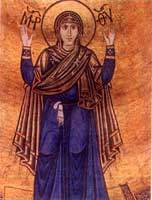 The icon has appeared in Ukraine approximately in 988. The earliest Russian icons, no matter in what city they were created, should be attributed to the Kiev School. This school was active from the end of the 10th century, the time of Christianization of Russia, until Kiev was sacked and burned by the Mongols in 1240. And even though there might have been some icon painting in Kiev after the fall of the capital, the center of icon painting moved to the north, to Novgorod. The icon has appeared in Ukraine approximately in 988. The earliest Russian icons, no matter in what city they were created, should be attributed to the Kiev School. This school was active from the end of the 10th century, the time of Christianization of Russia, until Kiev was sacked and burned by the Mongols in 1240. And even though there might have been some icon painting in Kiev after the fall of the capital, the center of icon painting moved to the north, to Novgorod.
The first icons were brought to Russia from the Byzantine Empire and from Bulgaria, which became an intermediary between Constantinople and Kiev, supplying the newly Christianized state with books, icons, and liturgical objects necessary for the celebration of the mass. We may suspect that the first painters in Kiev were also Greeks or Byzantinized South Slavs. They became teachers of the first Russian painters and gave them a sound training in the Byzantine style and tradition. Since Russians were always exceedingly adept not only at blind mimicking but at taking a step forward, they quickly learned how to extend the Byzantine style and tradition and make it their own. The early Russian (Kiev) style was still quite dependent on the Byzantine. The compositions were monumental, uncluttered, and simple. Some icons exhibited close affinities with the art of classical antiquity. Most Kievan School icons were painted in darker, more somber tones and were often large in dimensions because they were hand hewn with an axe from a large piece of wood. However, the Russians very quickly abandoned the Byzantine tradition of portraying Christ Pantokrator as a severe and strict judge and started developing a more "humane," understanding, and forgiving image of Christ, the Savior and the Redeemer. This tendency led later, in the Novgorodian and Moscow traditions to the development of a Savior type best known from the work of Andrei Rublev, and to the appearance of the "Russian" variants of many saints, particularly St. Nicholas and St. George.
The founder of the Kiev school is metropolitan Illariona, who has acted against dominance of the Byzantian Greeks in sphere of icon painting in territory of the Kiev Russia. Icon workshops were at temples of Saint Sofia and in Pechyorsky monastery, founded by Antony and Teodosy. Classical icon painting developed in Ukraine according to orthodox canons (but basically lime boards were used), icons were painted also on glass (basically in the Western Ukraine) and were embroidered on fabric. Mass demand for icons has caused to life unique phenomenon "people icon painting", i.e. many self-educated persons wrote icons on order and even painted rural churches and temples, bringing their own vision of saint images. During Soviet times many of temples were destructed. Because of mass burning of icons many natives from Ukraine worked basically abroad, painting there temples and creating icons. Now restoration of temples and revival of religious freedom of Ukraine citizens create the certain preconditions for new revival of Ukrainian icon painting.
|













 Culture and Art
Culture and Art  Painting
Painting  Icons
Icons